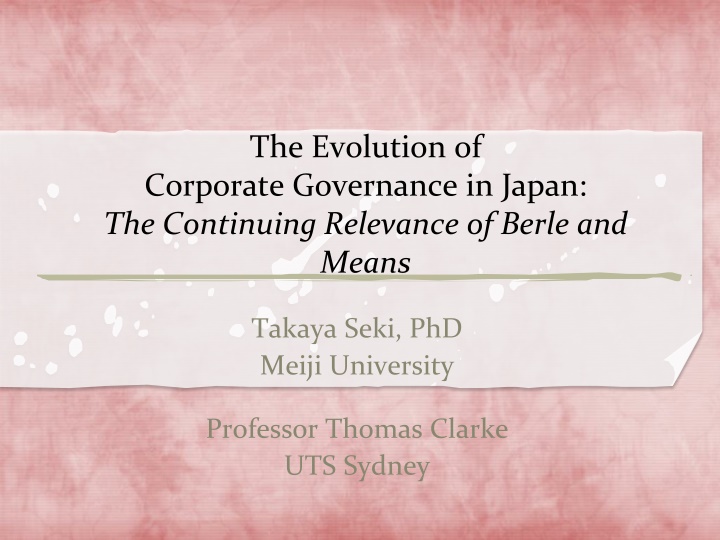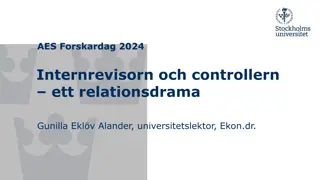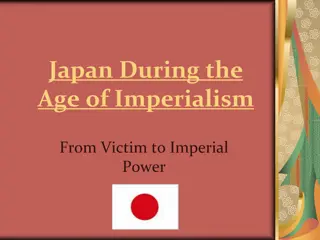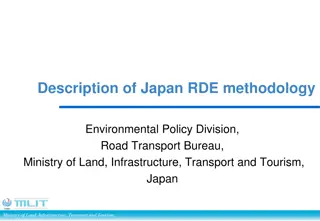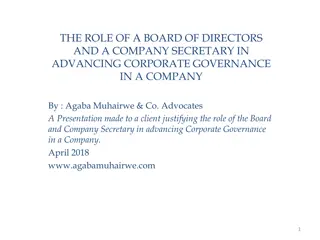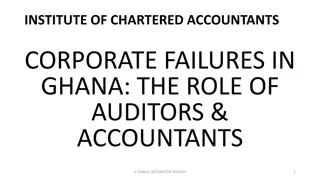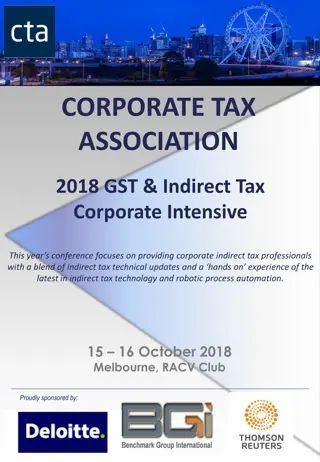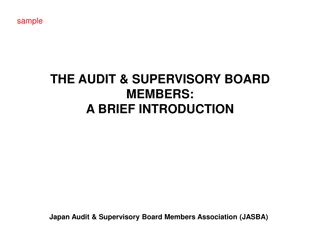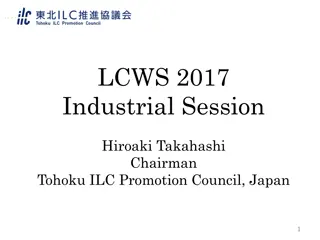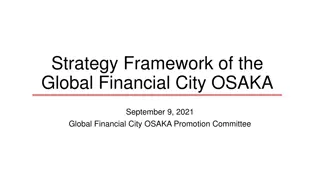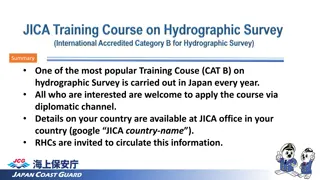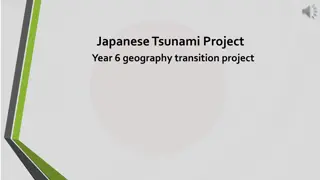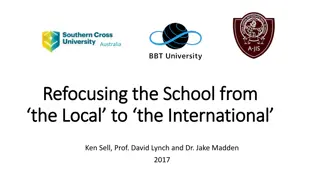Evolution of Corporate Governance in Japan: A Contemporary Perspective
The evolution of corporate governance in Japan is examined with a focus on the relevance of outside directors, board independence, corporate fraud, and disclosures. The changing landscape includes the appointment of independent members, remuneration levels, share ownership structure, and XBRL taxonomy for versatile disclosures. The future of corporate governance involves directors, share ownership, investors, and shareholder-company relations. Board structures are shifting towards more outside directors and non-voting members, with an emphasis on independence and accountability.
Download Presentation

Please find below an Image/Link to download the presentation.
The content on the website is provided AS IS for your information and personal use only. It may not be sold, licensed, or shared on other websites without obtaining consent from the author.If you encounter any issues during the download, it is possible that the publisher has removed the file from their server.
You are allowed to download the files provided on this website for personal or commercial use, subject to the condition that they are used lawfully. All files are the property of their respective owners.
The content on the website is provided AS IS for your information and personal use only. It may not be sold, licensed, or shared on other websites without obtaining consent from the author.
E N D
Presentation Transcript
The Evolution of Corporate Governance in Japan: The Continuing Relevance of Berle and Means Takaya Seki, PhD Meiji University Professor Thomas Clarke UTS Sydney
Popular perceptions Few outside directors Board independence in question Persisting corporate fraud and scandals Insufficient corporate disclosures Cross-shareholding structure 2 Takaya Seki, PhD
On the contrary Duties of directors severely tested leading to appointment of outside, independent members Substantially low level of remuneration Structure of share ownership fast changing Well-designed and versatile disclosures on corporate governance using XBRL taxonomy 3 Takaya Seki, PhD
Future of Corporate Governance Future of Directors Future of Share ownership Future of Investors Future of Shareholder=Company Relations Takaya Seki, PhD 4
Board Structure Dominated by inside/executive directors Number of outside directors on increase though slowly Kansayakus, non-voting board members are more outspoken and visual Much of the roles of audit committees are performed by Audit and Supervisory Board Members (Kansayakus) Stock Exchange mandates at least one independent board member (either from board of directors or audit and supervisory board) 5 Takaya Seki, PhD
Number of outside directors All listed companies (ca 3,500 companies) Top 200+ companies by capitalization headcount 7.4 0.9 11.4 1.8 Directors of whom outside Audit & Supervisory Board Members* of whom outside 3.5 4.4 2.3 2.6 *new translation of Kansayaku as recommended by JASBA (Nihon Kansayaku-Kyokai) All TSE listed companies 2.2 average number of dokuritsu-yakuin** headcount **independent outside members from directors or kansayaku as defined by the Tokyo Stock Exchange Takaya Seki, PhD 6
Background of outside directors Directors/Kansayakus From other company 62.6% Attorney-at-law 16.1% CPA /Tax Accountant 13.6% Academic and others 7.7% Of whom from major shareholders 19.2% Of whom from banks 11.1% Of whom from government bureaus 1.9% From TSE Corporate Governance White Paper 2013 Takaya Seki, PhD 7
Concepts of company law Underlying ideas of Company Law in Japan are very similar to other major economies Corporate personality in place (separation/independence of company asset) Shareholders own securitized asset of company (shares) and have residual claim Directors appointed by shareholders to look after company s asset, to serve the best interest of the company 8 Takaya Seki, PhD
Duties of directors Duty of care Duty to avoid conflict of interests Duty of loyalty Severely tested recently at Responsibilities over financial statements and internal control Hostile bid and takeover defense measure Corporate scandals and fraud Litigations from shareholders 9 Takaya Seki, PhD
Promotion of independent directors By Rulemakers Company Law Review Committee recommends nomination of outside directors Stock Exchange requires appointment of at least one independent director/kansayaku By Institutional Shareholders Pension Fund Association encourages investee to appoint outside directors ISS recommends negative votes for companies without outside directors Takaya Seki, PhD 10
Level of Executive Remunerations All listed companies (ca 3,500 companies) Top 200+ companies by capitalization Annual compensation in million yen Directors 21.4 38.5 of whom outside 3.5 7.6 Audit & Supervisory Board Members* of whom outside 9.1 20.6 2.3 2.6 Amount in million yen: divide by 100 to obtain Aus/US$ equivalent Takaya Seki, PhD 11
Executive remunerations Average payment modest compared with overseas competitors Highest paid are found among executives selected internally but their level not subject to market competition Individual disclosure required under limited cases, government intervention is minimal 12 Takaya Seki, PhD
Share ownership compared 2010 (%) Japan US UK Germany France Government, Local Government 6.2 2.9 2.3 8.7 9.0 18.0 3.8 19.0 Banks Insurance and Trusts 14.9 47.8 21.9 19.8 1.1 22.9 2.2 41.0 21.1 Non-financial Corporations 26.7 12.7 40.0 22.0 38.7 Overseas 20.3 39.5 15.0 11.0 11.5 Individuals Flow of Funds from each central bank (UK: Office of Statistics) Takaya Seki, PhD 13
Share ownership in Japan Insurance, Pensions and Trusts Non- Financial Corporations Government Banks Overseas Individuals (%) Total 3.1 12.6 11.9 11.0 0.0 61.3 1950 100.0 0.2 30.6 3.7 17.8 1.3 46.3 1960 100.0 0.6 13.7 19.2 23.9 4.9 37.7 1970 100.0 0.4 17.5 22.2 26.2 5.8 27.9 1980 100.0 0.3 20.9 23.8 30.1 4.7 20.4 1990 100.0 0.2 19.2 20.6 21.8 18.8 19.4 2000 100.0 0.3 14.7 16.8 21.2 26.7 20.3 2010 100.0 Source: Tokyo Stock Exchange 2012 Takaya Seki, PhD 14
Types of Keiretsu shareholdings Horizontal Keiretsu shareholding Mitsubishi, Sumitomo-Mitsui, Mizuho Vertical Keiretsu shareholding Automobiles, Large machineries, Retails Shareholding for maintaining relationship Vaguely defined as shareholding not be sold for profit taking or dividend Takaya Seki, PhD 15
Institutions Investing in Japan Domestic Pension/Assurance Investment companies Banks Business corporations Overseas US and European Pensions/Investment companies Short-term investors SWF and investments from new economies Takaya Seki, PhD 16
Shareholding structure in Asia State-ownership is prevalent in Asian economies. A number of them have established entities to oversee state-owned enterprises (SOEs) (for example, Temasek Holdings in Singapore, Khazanah Nasional in Malaysia, and the State-owned Assets Supervision and Administration Commission of the State Council in China). Indeed, state-ownership is perhaps one of the defining traits of the economic landscape of China, where the state held approximately 83.1% of market capitalisation in 2007. However, in many markets individuals and their families are dominant shareholders (for example, in Hong Kong, China). These individuals or families may control a large group of companies, with relatives and their advisers typically sitting as directors on group company boards. OECD (2011), Reform Priorities in Asia: Taking Corporate Governance to a Higher Level, Asian Roundtable on Corporate Governance www.oecd.org/daf/corporateaffairs/roundtables/asia Takaya Seki, PhD 17
Voting results at AGM Ratio of votes cast in favor of management policy (%) Votes by all shareholders* Votes by institutional shareholders** All agendas 95.4 81.2 Election of directors 95.4 76.4 Election of kansayakus 94.7 77.2 Remuneration packages 94.8 74.4 Approving Takeover defense measure 81.7 25.0 Shareholder Proposals 22.6 7.7 *From Annual Securities Reports **Analysis by Sumitomo-Mitsui Trust Bank Takaya Seki, PhD 18
What voting records indicate Institutions more critical on corporate governance issues Dissident private shareholders study voting styles of institutions to leverage their argument To avoid unnecessary discords: Companies need to agree on code of best practice with institutional investors so that investors can concentrate on nonrecurring matters Institutions also must be aware of their own accountabilities to ultimate owners Takaya Seki, PhD 19
Changing share ownership Impact of changing share ownership Ownership by banks and business corporation are on decrease Domestic Pensions/Assurance will maintain level of ownership but may remain inactive Investment companies with domestic/overseas clients will be more active in corporate governance Company directors find it increasingly difficult to establish relationship with short-term investors Stewardship Code in Japan? Companies feel impact of changing voting practice Institutions need to be aware of their duties to true owners Takaya Seki, PhD 20
Chain of Fiduciary in Japan Employees be answerable to Managers 1. Managers be answerable to Executives 2. Executives be answerable to Directors 3. 4. Directors be answerable to Shareholders Shareholders be answerable to Employees 5. Takaya Seki, PhD 21
Drive to accelerate changes Influence from Overseas New initiatives on corporate governance International institutional investors Lessons from accounting frauds and wrongdoing Kanebo, Seibu, Olympus Classic corporate crimes such as payments to racketeers or corruption are decreasing From participation by general public As ultimate owners of companies As taxpayers Takaya Seki, PhD 22
New initiatives Company Law Review Further measures to encourage companies to appoint at least one outside director* *Companies without outside directors will be required to state reasons justifying for not having any outside directors Introduction of audit and supervisory committee to oversee executive function Board Independence and Diversity By self-regulation through SE listings Institutional Stewardship Takaya Seki, PhD 23
APPENDIX 24 Takaya Seki, PhD
Corporate Governance in Japan Shareholders Meeting Independent Auditor Board of Directors (Torishimariyaku-kai) Kansayaku-kai (Audit and Supervisory Board) 25 Takaya Seki, PhD
Two formats of board structure Companies with Kansayaku Board of Directors (Torishimariyaku-kai) Audit and Supervisory Board (Kansayaku-kai) Companies with Iinkai Board of Directors with three statutory committees (audit, nomination and remuneration) Statutory Executive Officers including Chief Executive to be appointed by Board 26 Takaya Seki, PhD
CG in Japan, Participants Listed Companies (3,600) Shareholders (some cross-shareholding, institutional investors, individuals, overseas) Governments, etc. (FSA, METI, MOJ, TSE) Independent Auditor (Four major audit firms) Others influencing policies (business organizations, universities, professional firms) 27 Takaya Seki, PhD
Regulations over CG Company Law Company Law on Corporate Governance Civil Law on duties of directors Securities Regulation Transparency and accountability Responsibilities on Financial Statements Prohibiting insider trading/malpractices Stock Exchange regulations Independence of board members Parent-subsidiary listing 28 Takaya Seki, PhD
The Continuing Relevance of Berle and Means Takaya Seki, PhD 29
The Emergence of the Modern Corporation The modern corporation that emerged in the early part of last century was typified by Berle and Means as manifesting a separation of ownership and control, where professional managers were in a position to determine the direction of the enterprise and shareholders had surrendered a set of definite rights for a set of indefinite expectations (Berle and Means 1933:244) After the New Deal and the end of the second world war many US corporations in the 1950s and 1960s increased massively in scale and market domination, achieving pre- eminent positions in world markets. Takaya Seki, PhD 30
Technocratic Managerialism A new managerial and corporate mode of coordination of enterprise based on organization and planning had arrived as analysed by Coase (1937) and later Chandler (1977), transcending the market. This was an era celebrated in Galbraith s New Industrial State (1967) in which corporate growth and brand prestige apparently had displaced profit maximisation as the ultimate goals of technocratic managers, as planning and administration in close cooperation with government had displaced market relations as the primary corporate dynamic (Henwood 1988:259). In this technocratic milieu shareholders were passive and functionless, remarkable only in his capacity to share without effort or even without appreciable risk, the gains from growth by which the technostructure measures its success (Galbraith 1967:356). Takaya Seki, PhD 31
The End of an Idyll and Rise of Financialisation The Galbraithian idyll began to disintegrate with the severe recession of 1973/75, the incapacity of US corporations to compete effectively with Japanese and European products in key consumer market sectors, and the push towards conglomerate formation by Wall St which was interested in managing multiple businesses by financial performance. Subsequently, in successive waves, US corporations were subjected to further financial imperatives Over time purely financial interests have increasingly asserted their influence over hybridized giant corporations (Henwood 1998:262). Takaya Seki, PhD 32
Agency Theory and Shareholder Value A fertile scene was set for Michael Jensen, his colleagues in the Business and Law Schools at Harvard, and the Chicago school of economics, to develop a finance-based theory of corporate governance that was to envelop Anglo-American policy and practice. While agency theory and shareholder value were the most enduring principles of the Jensen legacy, they were preceded and accompanied by other financial innovations including leveraged buy-outs (LBOs), junk bonds and disgorging free cash flow (Lazonick 1992). For Jensen the stock market is always axiomatically the ultimate arbiter of social good (Henwood 1998:269). However the result of eliminating the free cash flow of companies in leveraged buy-outs, and in loading up companies with debt, was to leave US companies without capital to invest in research and development at a time of increasing competition from overseas companies engaged in continuous product development (Blair 1993) Takaya Seki, PhD 33
Corporations and Shareholders Such financial innovation amounted to Jensen to the eclipse of the public corporation (Harvard Business Review 1989) This article received a robust response. Peter R na, head of Schroder Bank in New York, maintained that by exclusively privileging shareholder interests Jensen pre-empted thoughtful analysis of the very question that is at the heart of the issue what should be the rights and privileges of shareholders? R na questioned Jensen s assumption that shareholders are better judges of capital projects than managers and corporate boards as an ideologically inspired assertion that lacks empirical support (1989). Takaya Seki, PhD 34
A Tale of Two Systems The increasingly aggressive market for corporate control in the 1970s and 1980s was not primarily efficiency-enhancing as Jensen maintained, and there is little support for the inefficient management displacement hypothesis (Ravenscraft and Scherer 1989). Meanwhile with a keen focus on product development, high quality, and growth in market share for the long term Japanese corporations turbo-charged their way to market dominance in major sectors of the Western economies in the 1970s and 1980s. The Japanese economic miracle inspired (and invested in) the rapid economic development of the East Asian economies The bursting of the Japanese bubble in the early 1990s coincided with the revival of the US economy around software industries in the 1990s, and finance in the 2000s Takaya Seki, PhD 35
Japans GDP Growth 1961 to 1999 Takaya Seki, PhD 36
Japans GDP Per Capita Relative to US 1961-1999 (ppp) Takaya Seki, PhD 37
The Financialisation of Japanese Corporations? Japanese economic institutions were well suited to both post war reconstruction and catching up with other advanced economies, but not to surpassing them. Japan s catch up was essentially complete by the late 1980s. The business- government cooperation and bank-centered corporate governance that served Japan well for decades are now ill- suited in critical ways to guiding Japan further forward. Yet these institutions continue with an inertia that reduces Japan s ability to find and invest in new economic opportunities, including new enterprises. If equity markets to play a fuller role requires dismantling of inter-corporate equity holdings, more transparent corporate decision-making, and corporate governance that is more responsive to shareholder pressure. (Morck and Yeung) Takaya Seki, PhD 38
The Ongoing Governance Debate in Japan A tension between the company as community, and the company as property (Buchanan, Chai, and Deakin 2012) On one side traditional Japanese corporate governance, characterised by features such as the power of internally promoted management to run large, listed companies with minimal external supervision, concern with the company as a continuing community, and a lack of direct attention to shareholder interests (Buchanan and Deakin 2007: p.1). On the other side the view that in order to restore the national economy to good health, Japanese business needed to adhere to an emerging global consensus in corporate governance (Ahmadjian, 2003, p.222). Takaya Seki, PhD 39
Activist Hedge Funds and Corporations The growing contrast between the US emphasis on shareholder value and the Japanese indifference to shareholder rights was widely remarked on, but had few practical effects because the two systems had few opportunities to impact on one another. All of this changed with the emergence of hedge fund activism in Japan. American activist hedge funds were often confrontational investors who targeted companies which they believed were squandering shareholder value. As this strategy was successful in generating above-market rates of return for the funds and their own investors, they turned to other markets, in Europe and in Japan. In Japan, the approach of the funds came into immediate conflict with the idea and practice of the community firm which still retained widespread support (Buchanan, Chai, and Deakin 2012:5) Takaya Seki, PhD 40
The enduring relevance of the key questions of Berle and Means: Whose interests should a company serve? Is it the property of shareholders, for them to do whatever they want with it, or does it have a wider social purpose? Geoffrey Owen (Financial Times 27 June 2012) Takaya Seki, PhD 41
A Contest of Principles Managers of the targeted companies, for their part, had little interest in shareholder value; they barely understood what the words meant. What mattered to them, and what constituted corporate value in their view, was not the share price or any other financial measure, but the ability of the company to prosper and to grow over the long term (Financial Times 27 June 2012) What followed was a tournament of corporate governance beliefs. Activist hedge funds, often of foreign origin, but sometimes Japanese, used the formal legal rights conferred on shareholders by Japanese company law and by companies own articles of association to mount a fundamental challenge to the core of management practice in the community firm. In doing so, they drew out into the open a range of issues that had previously been uncontroversial concerning managerial autonomy and accountability, the balance in dividend policy between the distribution of income and the accumulation of reserves, and the optimal level of financial gearing for companies ((Buchanan, Chai, and Deakin 2012:5). Takaya Seki, PhD 42
Hedge Fund or Company? When Steel Partners attempted to acquire Bull-Dog Food Company, Bull-Dog adopted a defence strategy Steel claimed illegal, but Tokyo High Court ruled the US hedge fund an abusive acquirer. Similar contest between British hedge fund The Children s Investment Fund intervention in J-Power demonstrated aggressive tactics by activist investors not likely to succeed in Japan However the Japanese system has become more shareholder friendly during this period, and dialogue is taking place about higher standards of governance and accountability But the survival of the company as an enduring successful business remains more important in Japan than investors who hold shares at any given time (Financial Times 27 June 2012) Takaya Seki, PhD 43
Conclusions Japan has much to learn from the West about corporate governance, transparency and accountability The West has much to learn from Japan about the conception of the corporation as a community, and directors and executives commitment to enduring business success Takaya Seki, PhD 44
Takaya Seki PhD (Econ, Kyoto University) BSc (Imperial College, London) Assistant Professor, Meiji University, Tokyo Managing Director, Corporate Practice Partners, Inc., Tokyo Professor, Reitaku University, Kashiwa, Japan Non-Executive Director, Anritsu Corporation, Atsugi, Japan Advisory Committee on Corporate Governance (Ministry of Economy Trade and Industry, Financial Services Agency) Thomas Clarke Director Centre for Corporate Governance UTS Sydney Takaya Seki, PhD 45
